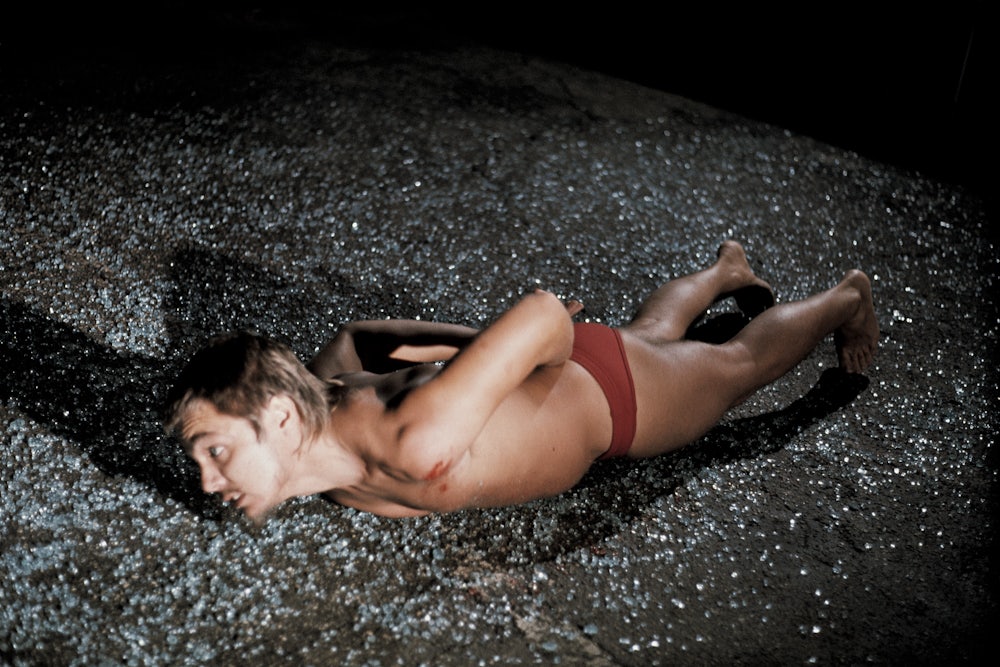Chris Burden, who died in 2015, will always be known as the artist who had himself shot. Unless he is known as the one who had himself crucified (nailed through the hands to the roof of a Volkswagen). Either way, he is the most famous performance artist of the 1970s after Yoko Ono, and the father of the avant-garde movement that uses the human body’s capacity for suffering as a medium.
“Endurance art” feels like the natural form for our times, since we love spectacle and violence and people causing drama in public. Emma Sulkowicz’s Mattress Performance: Carry That Weight was endurance art (she carried a dorm-room mattress around campus, declaring she would put it down only at graduation or her alleged rapist’s expulsion). Marina Abramovic is the most famous endurance artist of our time, pitting herself against the body’s limits in works like 2003’s The House With the Ocean View (in which she went 12 days without food) and the Rhythm series of the early 1970s (in which she submitted to, among other things, cuts with a razor blade). But “stunt” performance of the kind that drifts through the news cycle now (the guy who nailed his scrotum to the ground in Moscow, the guy who showed up naked in a box to the Met gala this year) has not always felt so familiar.
In the 1970s art that involved the body was a genuine innovation. Burden, a new documentary by Timothy Marrinan and Richard Dewey, looks back over Chris Burden’s career, inviting his old college friends and critical talking heads alike to opine over archival footage. There is new footage here too, following Burden as he wanders across his California estate in the months before his death.
The documentary affirms the traditional view of Burden’s career as falling into two main parts: A dark and manic 1970s full of violent performances, then a considerably more chilled later output. From the mid-80s until his death, he produced large and often mobile sculptural installations of surprising sweetness and generosity. The best known must be Urban Light (2008), the forest of lampposts installed outside the Los Angeles County Museum of Art, where tourists like to propose to each other and Instagram themselves and so on.
“Evel Knievel and I are two different people,” Burden once said. He had to make this statement after profiles in Newsweek and Esquire made him famous to Americans as a stuntman of the art world. In 1971’s Shoot, he was just supposed to be scratched lightly. But at the last minute, the conscripted friend pulled slightly to the left; Burden was shot right through the arm.
The violence of that piece captured American imaginations. Guns are part of the mythology of American identity, from cowboys to cops, while the Vietnam War made shooting an intimate and recent experience for many young men. In the documentary, a friend of Burden’s describes how quiet the room went before the shot, the visceral tension, the direct connection she felt between her body and his. “Everybody fantasizes about being shot,” Burden says. The intimacy of the footage of the work is shocking.
Burden was the right artist for America at that moment, and he became a celebrity. He also became an unstable asshole, by all accounts. His work could be aggressive to others. In 1972’s TV Hijack, he held a knife to his friend’s throat on screen and demanded to “go live.” He also confessed to an extramarital affair on television, which his then-wife Barbara describes in the movie as unpleasant. He became obsessed with guns and began to carry around a loaded Uzi.
Ironically, his most productive time artistically was when he was settled quietly with Barbara: She supported him while he worked on his endurance projects, and even considered nailing his hands for him in Trans-Fixed (1974), though she later bailed. In that decade he certainly seems to have been a man of two halves. In the documentary, a friend of Burden’s describes having a stoned hallucination during a performance, in which Burden split into two identities. One was kind, trustworthy, genuine, the other a clever trickster whom you “wouldn’t trust for a second.”
Does it matter that Burden could be an awful man? In a way, it does, because gender is always pertinent to discussions of fine art. It is tempting to posit that endurance art has always been coded male in the public discourse, since physical strength and violence are associated with masculinity. One thinks of early works like Vito Acconci’s Seedbed (1971), a marathon piece in which the artist masturbated eight hours a day under a boardwalk in a gallery.
But women have made work like this for at least as long as men. Valie Export was born six years before Burden, and in 1971 filmed herself rolling on broken glass and then paper, leaving marks of blood. In 1973’s Hyperbulie, she crawled naked through a maze of electrified wires, receiving a shock each time she actually touched one. The comic stereotype of a performance artist is maybe intrinsically female, a deranged woman painting with her genitals. Complicating this question are the new dynamics of celebrity and spectacle in performance art of the early 1970s, which make it difficult to trace its contours accurately.
Nonetheless, Burden does a sterling job. The documentary makers have worked hard to celebrate the artist’s later works, showing captivating footage of pieces like Beam Drop (1983) and Metropolis (2011). They have also roped in an extraordinary array of talking heads, from the moronic Brian Sewell to Peter Schjeldahl to Frank Gehry to, bizarrely, John McEnroe (a big Burden fan, apparently). And the movie shows that the historiography of Chris Burden is at least as interesting as the work itself. Perhaps they could do Valie Export next.
